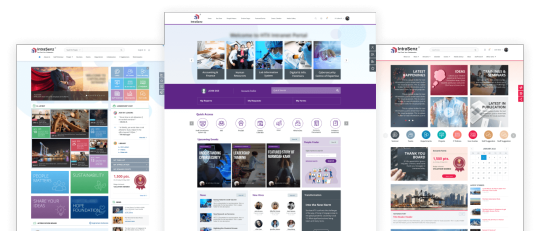#Employee Collaboration
Explore tagged Tumblr posts
Text
Transform Your Workplace with Innovative SharePoint Intranet Solutions
🏢🌐 Elevate Your Work Environment with Total eBiz Solutions' SharePoint Intranet Solutions! 🌐🏢
Discover the future of employee collaboration and experience a digital workplace like never before with Total eBiz Solutions. Introducing Intrasenz, our cutting-edge SharePoint Intranet solution designed to empower your workforce and revolutionize the way you work.
🔹 Unleash Collaborative Potential: Say goodbye to silos and hello to seamless collaboration. Intrasenz fosters a culture of teamwork, enabling employees to connect, share insights, and co-create effortlessly.
🔹 Empower Your Digital Workplace: Embrace the era of flexible work arrangements with Intrasenz. Access critical information, documents, and tools from anywhere, enhancing productivity and fostering a modern, agile workplace.
🔹 Elevate Employee Experience: Put your employees at the heart of everything you do. Intrasenz enhances engagement, communication, and overall job satisfaction, leading to a more motivated and productive workforce.
🔹 Tailored for Success: Total eBiz Solutions understands that each organization is unique. Intrasenz is customizable to fit your specific needs, ensuring you get a tailored intranet solution that aligns perfectly with your goals.
🔹 Experience Seamless Integration: Intrasenz seamlessly integrates with SharePoint, leveraging the power of a trusted platform to provide a unified, intuitive user experience that drives efficiency.
Unlock the potential of your workplace with Total eBiz Solutions' Intrasenz. Visit our website to explore how this innovative SharePoint Intranet solution can transform your organization's employee collaboration and digital workplace.
🌐 Learn more:
SharePointIntranet #IntranetSolutions #EmployeeCollaboration #DigitalWorkplace #EmployeeExperience #Intrasenz #ProductivityTools #ModernWorkplace
, Intranet Solutions, Employee Collaboration, , Employee Experience, Intrasenz, Productivity Tools, Modern Workplace

#SharePoint Intranet#Intranet Solutions#Employee Collaboration#Digital Workplace#Productivity Tools#Modern Workplace
0 notes
Text
Dcxdp
Dan/Danny/Dani 4/5
After leaving Amity Park, Danny and Jazz had settled in Gotham. Danny got a low level security guard job at Wayne Enterprises while Jazz started her job at Arkham Asylum. Most would assume Danny had the job with the least drama.(They would be wrong.)
You see, while Danny was a security guard, he also would occasionally help out in other departments, which lead to some people getting…. possessive.
The Aerospace department had already practically adopted Danny after he ranted about how cool space was and came up with several feasible features to a new design. R&D found Danny to be a delightfully clever person whose brain was on par with their best minds, and they would trade their souls to pick his brain. Biotech adored his outlook on things and his weirdly accurate observations. The Cybersecurity department had never met anyone who could make better firewalls(though he did promise his friend Tucker, who he apparently learned everything from, would apply soon.) Even Legal liked him, since he was good with paperwork and pointing out possible loopholes.
Security was fighting the other branches back with a stick. Danny was theirs first!
#everyone loves danny#dcxdp#dc x dp#funny#the only thing all departments agree on is Danny is amazing#and that they had to make sure no one else took him#whenever they collaborate with another company#they make sure Danny is with a different department and kept busy#Danny is oblivious#the employees are debating whether or not to get him adopted#or have him marry in#or if they should just block the Wayne’s from meeting him all together#meanwhile Jazz’s main patient is Waylon Jones#and he adores her
972 notes
·
View notes
Text
MY SISTER’S ABUSIVE CO-WORKER HAS BEEN FIRED

#g talks#my sister submitted a scathing report in collaboration with accusations from a couple other employees#just a couple days ago#apparently she just got canned this morning#mine#/mobile#/okay to reblog
18 notes
·
View notes
Text
every time jun has gone back to China for activities I become more and more done with XCSS (Pledis China)... it's so clear they're incompetent and don't understand how the Chinese entertainment industry works 🙃
#either that and/or theyre deliberately sabatoging jun#which like... i do abide by the whole 'dont attribute to malice what you could attribute to incompetence' thing#but also at this point its ridiculous...#a very summarized version is that in china its very common practice for companies to collaborate directly with official fanbases#so fanbases can organize events and provide promotion and support etc.#like its hard to explain but fanbases are more official organizations that are an important part of the entertainment industry#its basically a job for some people#but xcss/pledis has not been properly communicating with juns fanbases (jfortepiano and jun bar)#and its been causing a lot of issues#theyre also not following certain social media conventions for events apparently#all of which is hurting the promotion of juns acting activities#its also not a good look when every other actor has this fan support and jun either doesnt have any or has last minute stuff put together#bc the fanbases were not given proper notice/communication from the company#also im saying this as someone who has actually defended pledis (korea) for many things so like#yall know i wouldnt be complaining about this if it was just a small thing or there was some other explanation for it#the best explanation is that theyre incompetent and are treating c-ent like its k-ent when its not#but after all these years shouldnt they have learned by now and hired people who know what theyre doing??#might delete this but i needed to rant#its also frustrating when so called carats insult jun for doing solo activities and act like he thinks hes above svt#when hes not even getting proper support for his solo activities from the company 🙃#like no babes i promise this is not easier for him 😭#also i have to wonder what the xcss employees even do most of the time...#as far as i know they dont have any artists that promote solely in korea so jun and minghao should be their main priotities right???#but they seem to do jack shit whether chinaline is in korea or back in china to promote stuff#like not even the bare minimum half the time#ugh anyway#melia.txt
18 notes
·
View notes
Text
...how tf did the organization that both chris & jill founded & were basically the co-ceos of just. become corrupt?? like. ?????? what tf happened to the bsaa???????
#chris redfield#p.#me looking at re7 & 8: what tf actually happened to chris?#none of it was ever explained. just that now he has his own thing going on w like 5 employees & also collaborates w fucking. good umbrella..
8 notes
·
View notes
Text
French initiative for responsible AI leaders - AI News
New Post has been published on https://thedigitalinsider.com/french-initiative-for-responsible-ai-leaders-ai-news/
French initiative for responsible AI leaders - AI News
ESSEC Business School and Accenture have announced the launch of a new initiative, ‘AI for Responsible Leadership,’ which marks the 10th anniversary of the establishment of the role of Chair at ESSEC, titled the ESSEC Accenture Strategic Business Analytics Chair.
The initiative aims to encourage the use of artificial intelligence by leaders in ways that are responsible and ethical, and that lead to high levels of professional performance. It aims to provide current and future leaders with the skills they require when faced with challenges in the future; economic, environmental, or social.
Several organisations support the initiative, including institutions, businesses, and specialised groups, including ESSEC Metalab for Data, Technology & Society, and Accenture Research.
Executive Director of the ESSEC Metalab, Abdelmounaim Derraz, spoke of the collaboration, saying, “Technical subjects are continuing to shake up business schools, and AI has opened up opportunities for collaboration between partner companies, researchers, and other members of the ecosystem (students, think tanks, associations, [and] public service).”
ESSEC and Accenture aim to integrate perspectives from multiple fields of expertise, an approach that is a result of experimentation in the decade the Chair has existed.
The elements of the initiative include workshops and talks designed to promote the exchange of knowledge and methods. It will also include a ‘barometer’ to help track AI’s implementation and overall impact on responsible leadership.
The initiative will engage with a network of institutions and academic publications, and an annual Grand Prix will recognise projects that focus on and explore the subject of AI and leadership.
Fabrice Marque, founder of the initiative and the current ESSEC Accenture Strategics Business Analytics Chair, said, “For years, we have explored the potential of using data and artificial intelligence in organisations. The synergies we have developed with our partners (Accenture, Accor, Dataiku, Engie, Eurofins, MSD, Orange) allowed us to evaluate and test innovative solutions before deploying them.
“With this initiative, we’re taking a major step: bringing together an engaged ecosystem to sustainably transform how leaders think, decide, and act in the face of tomorrow’s challenges. Our ambition is clear: to make AI a lever for performance, innovation and responsibility for […] leaders.”
Managing Director at Accenture and sponsor of the ESSEC/Accenture Chair and initiative, Aurélien Bouriot, said, “The ecosystem will benefit from the resources that Accenture puts at its disposal, and will also benefit our employees who participate.”
Laetitia Cailleteau, Managing Director at Accenture and leader of Responsible AI & Generative AI for Europe, highlighted the importance of future leaders understanding all aspects of AI.
“AI is a pillar of the ongoing industrial transformation. Tomorrow’s leaders must understand the technical, ethical, and human aspects and risks – and know how to manage them. In this way, they will be able to maximise value creation and generate a positive impact for the organisation, its stakeholders and society as a whole.”
Image credit: Wikimedia Commons
See also: Microsoft and OpenAI probe alleged data theft by DeepSeek
Want to learn more about AI and big data from industry leaders? Check out AI & Big Data Expo taking place in Amsterdam, California, and London. The comprehensive event is co-located with other leading events including Intelligent Automation Conference, BlockX, Digital Transformation Week, and Cyber Security & Cloud Expo.
Explore other upcoming enterprise technology events and webinars powered by TechForge here.
#accenture#ai#ai & big data expo#ai news#amp#Analytics#anniversary#approach#artificial#Artificial Intelligence#automation#Big Data#Business#business analytics#california#Cloud#Collaboration#Companies#comprehensive#conference#cyber#cyber security#data#data theft#deepseek#deploying#Digital Transformation#economic#education#employees
3 notes
·
View notes
Text
How do you stay professional while being friendly at work?

In my experience, I've come to realize how crucial it is to maintain the right balance between friendship and professionalism in the workplace. Building and keeping good relationships is important but it's just as essential to establish clear boundaries between causual conversation and work tasks.
Here are some of key points I've found helpful:
Set boundaries - it's vital to differentiate between casual chats and focusing on the tasks at hand
Respect other's space and time - always keep in mind that we're at work and everyone has their duties that need attention and completion on time
Communicate respectfully - being polite and professional in all situations, even informal ones is key. One careless word can negatively affect the workplace dynamic
Stay positive - a supportive attitude makes a huge difference. Being in a constant bad mood can influence the entire team and make work progress harder
How do you balance being friendly while staying professional at work?
...
#workfromhome #workfromhomeonline #remotework
#employees#employers#work together#home office#comfy#comfy work#work from anywhere#proffesional life#collaboration#workbalance#flexibility#productivity hacks#team work#office life#office productivity#office problem#remotework#remote working#work from home#daily english#english education
3 notes
·
View notes
Text
Beyond the Boardroom: Mixing Business with Pleasure
Mixing business and pleasure is not a fleeting trend but a comprehensive strategy that can lead to productivity and improved well-being.
In the modern business landscape, the age-old adage of “never mix business with pleasure” seems to be undergoing a significant transformation. As the lines between professional and personal lives increasingly blur, a new paradigm emerges, advocating for a harmonious blend of business activities with leisure pursuits. This approach, often encapsulated in the phrase “mixing business and pleasure,”…

View On WordPress
#adaptive work cultures#balance in professional settings#boundary setting#business and leisure integration#business innovation#career advancement#collaboration techniques#corporate culture evolution#corporate retreats#creative inspiration#cultivating professional friendships#digital nomad lifestyle#diversity and inclusion#effective communication#employee well-being#engaging work experiences#enhancing team cohesion#entrepreneurial lifestyle#flexible work arrangements#fostering creativity in the workplace#hybrid work models#inclusivity in the workplace#innovative business practices#job satisfaction enhancement#leisure activities in business#leisure-driven productivity#modern workplace dynamics#navigating professional landscapes#networking strategies#personal and professional growth
2 notes
·
View notes
Link
7 notes
·
View notes
Text
Boost Teamwork with Employee Collaboration Training – Acrux Consulting
Strengthen workplace synergy with Acrux Consulting's expert employee collaboration training in USA. Our tailored workshops enhance teamwork, communication, and productivity for long-term success. Empower your employees today!

Visit Here For More Info:- https://acruxconsult.com/team-development/
0 notes
Text
How Workplace Communication Shapes Leadership Effectiveness
💬 The Secret to Great Leadership? Mastering Workplace Communication! Effective leaders know that communication is the foundation of success. Without clear messaging, open dialogue, and active listening, even the best strategies fall apart. Strong communication helps leaders: ✔ Build trust and credibility ✔ Align teams with organizational goals ✔ Foster collaboration and innovation ✔ Boost employee engagement and morale But communication isn’t just about talking—it’s about listening, adapting, and creating a culture of transparency. Leaders who master communication create high-performing teams that thrive. 📢 What communication strategies have helped you become a better leader? Let’s discuss! #Leadership #Communication #EmployeeEngagement #WorkplaceSuccess #TrustMatters #Influence #Teamwork
Introduction Communication is the foundation of effective leadership. No matter how skilled or knowledgeable a leader may be, their success is often determined by how well they communicate their vision, inspire their team, and foster collaboration. In today’s fast-paced and highly connected workplace, strong communication skills are more critical than ever. Leaders who communicate effectively…
#active listening#business communication#company culture#Effective Leadership#employee engagement#leadership communication#leadership development#open dialogue#team collaboration#trust in leadership#workplace culture#workplace transparency
1 note
·
View note
Text
Streamline Your Workflow with Microsoft 365 Suite Deployment Services in 2025
In today’s fast-paced business environment, achieving efficiency and seamless collaboration is critical to staying ahead. The Microsoft 365 Suite offers a comprehensive range of tools designed to streamline workflows, enhance productivity, and foster better communication. However, to unlock its full potential, businesses need tailored deployment services that align with their specific goals and operational requirements.

Why Microsoft 365 Suite is Essential in 2025
Unified Communication and Collaboration Microsoft Teams, SharePoint, and Outlook provide integrated platforms that support real-time communication, file sharing, and collaboration across teams—whether they’re in the same office or dispersed globally.
Enhanced Productivity with AI and Automation Tools like Microsoft Viva and Power Automate bring AI-driven insights and automation capabilities, enabling businesses to reduce manual tasks and focus on strategic initiatives.
Scalable and Secure Solutions With advanced security features and compliance tools, Microsoft 365 ensures businesses can scale their operations confidently while safeguarding sensitive data.
Flexibility for Hybrid Work Models The suite’s cloud-based architecture empowers employees to work from anywhere, ensuring a seamless transition between remote and on-site operations.
The Importance of Professional Deployment Services
While Microsoft 365 offers robust features, implementing it effectively can be challenging without expert guidance. Professional deployment services are crucial for:
Customised Solutions: Tailoring the suite’s features to your business’s unique needs ensures maximum ROI.
Efficient Migration: Migrating data from legacy systems with minimal disruption requires technical expertise.
Training and Support: Ensuring your teams are equipped to leverage the suite effectively enhances adoption rates.
Ongoing Optimisation: Regular assessments and updates keep your systems aligned with evolving business objectives.
Addressing Modern Business Challenges
Reducing Silos By integrating tools like Teams, OneDrive, and Planner, organisations can eliminate data silos and promote cross-departmental collaboration.
Improving Decision-Making Power BI within Microsoft 365 provides actionable insights through real-time analytics, enabling leaders to make informed decisions swiftly.
Boosting Employee Engagement Features like Viva Insights prioritise employee well-being and productivity, helping organisations retain top talent.
Key Considerations for Microsoft 365 Deployment
Assess Your Business Needs: Understand your current challenges and how Microsoft 365 can address them.
Plan for Change Management: Foster a culture of adaptability to ensure smooth adoption.
Focus on Security: Leverage tools like Microsoft Defender to mitigate cybersecurity risks.
Partner with Experts: Collaborate with experienced providers to ensure a seamless deployment process.
Conclusion
Microsoft 365 Suite is not just a productivity tool; it’s a strategic asset for driving innovation and efficiency in 2025. By partnering with a trusted deployment service provider, businesses can ensure a smooth transition, empowering their teams to achieve more while staying agile in a competitive landscape.
Ready to revolutionise your workflow? Explore how Microsoft 365 Suite deployment can transform your business today.
#Microsoft 365 Suite deployment#Microsoft 365 migration services#Cloud-based collaboration tools#Hybrid work solutions#Microsoft Teams integration#Secure data management#AI-driven business tools#Customised Microsoft 365 implementation#Enhanced business collaboration#Power BI analytics for businesses#Microsoft 365 professional deployment#Data security in Microsoft 365#Employee engagement with Microsoft Viva
0 notes
Text
Psychological Safety at Work

Simply hiring talent is not sufficient. For people to perform at their best, it is essential that they work in an environment that is psychologically safe, along with many other factors, such as having a clear sense of purpose.
There is growing recognition that psychological safety plays an important role in team performance and decision-making. Additionally, it promotes openness, creativity, and risk-taking. Psychologically secure environments allow individuals to voice their opinions and express difficult concerns without fear of punishment or retribution. There is no fear of standing out, being wrong, or offending those in authority.
In a psychologically safe environment, interpersonal fear is not a hindrance to people’s participation. The individual is willing to take the interpersonal risk associated with candor. Holding back and not participating fully is more uncomfortable than taking the risk of sharing an unpleasant viewpoint. The feeling of safety encourages people to ask bold questions, seek assistance, and foster creativity that contributes to the organization’s success.
Strengthscape’s Leader’s Toolkit to Foster Psychological Safety program clarifies the meaning of psychological safety and provides a practical guide for promoting it within organizations and teams. This program provides leaders with the tools they need to create a psychologically safe environment in their teams while utilizing the talents of those teams to benefit their organizations.
#Leadership Development#Creativity in Teams#Risk-Taking in Organizations#Fostering Openness#Leader’s Toolkit#Strengthscape Programs#Organizational Success#Safe Work Environment#Interpersonal Fear#Workplace Innovation#Team Collaboration#Leadership Training#Promoting Candor#Effective Teams#Employee Empowerment
0 notes
Text
The Makings of a VALUABLE Employee that Any/All Employers Should Want
The following are characteristics and areas that I have always believed in and still continue to believe in. They are aspects that every employee should be striving to achieve in any line of work. I know this fairly well, to the detriment of folks around me in my social/work circles because of having sacrificed so much personal time from when I gained my first grad degree and then later…
#adaptability#brain plasticity#cognitive diversity#collaboration#creativity#fast learner#good learner#learning#potential employee#problem solving#sharing#valuable employee#valuable potential employee
0 notes
Text
AI agents: Automation and intelligent assistance (2025 guide)
New Post has been published on https://thedigitalinsider.com/ai-agents-automation-and-intelligent-assistance-2025-guide/
AI agents: Automation and intelligent assistance (2025 guide)

Imagine having a personal assistant who can not only schedule your appointments and send emails but also proactively anticipate your needs, learn your preferences, and complete complex tasks on your behalf.
That’s the promise of AI agents — intelligent software entities designed to operate autonomously and achieve specific goals.
What are AI agents?
In simple terms, an AI agent is a computer program that can perceive its environment, make decisions, and take actions to achieve a defined objective. They’re like digital employees, capable of handling tasks ranging from simple reminders to complex problem-solving.
Prompt engineering: How to talk to AIs like ChatGPT?
This article serves as a primer on prompt engineering, delving into the array of techniques used to control LLMs.

Key characteristics of AI agents
Perception: Agents can sense their environment through sensors (like cameras, microphones, or data feeds). Think of it like our senses: sight, hearing, touch, etc., that give us information about the world around us.
Decision-making: Based on their perception, agents use AI algorithms to make informed decisions. This is like our brain processing information and deciding what to do next.
Action: Agents can perform actions in their environment, such as sending emails, making purchases, or controlling devices. This is like our bodies carrying out the actions our brain decides upon.
Autonomy: Agents can operate independently without constant human intervention. They can learn from their experiences and adapt to changing circumstances. This is similar to how we learn and become more independent over time.
Types of AI agents
Simple reflex agents: These agents react directly to their current perception. Like a thermostat, they turn on the heat when it’s cold and turn it off when it’s warm.
Model-based reflex agents: These agents maintain an internal model of the world, allowing them to make decisions based on past experiences. Imagine a self-driving car using a map to navigate.
Goal-based agents: These agents have specific goals they are trying to achieve. They make decisions based on how close they are to reaching their objective. Think of a robot trying to solve a maze.
Utility-based agents: These agents try to maximize their “utility” or happiness. They consider multiple factors and choose the action that will lead to the best overall outcome. Imagine an AI agent managing your finances, trying to maximize your returns while minimizing risk.
Analogies for understanding AI agents
A self-driving car: It perceives its surroundings (other cars, pedestrians, traffic lights), makes decisions (accelerate, brake, turn), and takes actions (controls the steering wheel, brakes, and accelerator).
A smart thermostat: It senses the temperature, makes decisions (turns on/off the heating/cooling), and takes action (controls the HVAC system).
A personal assistant: They perceive your schedule, make decisions (schedule meetings, send reminders), and take actionturns (send emails, make phone calls).

Future uses of AI agents
The future of AI agents is brimming with possibilities:
Personalized education: AI tutors that adapt to each student’s learning style and pace.
Healthcare management: AI agents that monitor patients’ health, schedule appointments, and provide personalized health advice.
Smart homes and cities: AI agents that optimize energy consumption, manage traffic flow, and enhance public safety.
Complex problem solving: AI agents that can collaborate with humans to tackle complex scientific, economic, and social challenges.
Challenges and Considerations:
While the potential of AI agents is immense, there are challenges to address:
Ethical considerations: Ensuring agents make fair and unbiased decisions.
Safety and reliability: Making sure agents operate safely and reliably in complex environments.
Transparency and explainability: Understanding how agents make decisions.
Conclusion
AI agents represent a significant step towards a more automated and intelligent future. By understanding their capabilities and addressing the associated challenges, we can unlock their full potential and create a world where AI agents work alongside us to make our lives easier, more productive, and more fulfilling.
Check out the event calendar for 2025 and see where we’ll be throughout the year.
Get your ticket today and network with like-minded individuals.

Like what you see? Then check out tonnes more.
From exclusive content by industry experts and an ever-increasing bank of real world use cases, to 80+ deep-dive summit presentations, our membership plans are packed with awesome AI resources.
Subscribe now
#2025#Advice#agent#agents#ai#ai agent#AI AGENTS#Algorithms#Article#Artificial Intelligence#automation#bank#Brain#Calendar#Cameras#Cars#chatGPT#cities#collaborate#computer#content#cooling#data#devices#driving#economic#education#emails#employees#energy
0 notes
Text

Do you prefe working at home, alone or with others?
In today's world, many of us have the flexibility to work in defferent environments. Some people thrive in the quiet of working from home, While others find energy and motivation working alongside colleagues. Each option has its own benefits: working from home offers flexibility and focus, while working with others can boost creativity and collaboration.
Of cours, working from home is convenient no time or money wasted on commuting and nobody interrupts you. Plus I can stay comfy in my favorite sweatpants! But personally, I prefer working with colleagues, though not in a large group. I enjoy communicating with people and it keeps me motivated and engagedin my tasks.
What works best for you? Do you find yorself more productive working alone or do you prefer the dynamic of being with others?
...
#productivity hacks#flexibility#work#office#work at home#work balance#collaboration#employees#employers#comfy#comfy style#home office#professional#proffesional life#work together#work from anywhere#psychology#daily english
3 notes
·
View notes